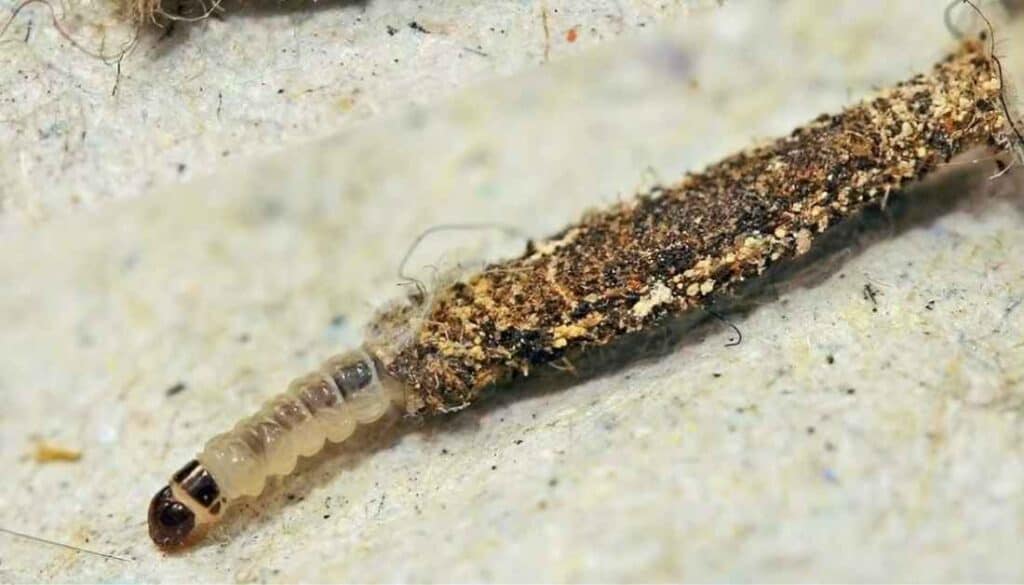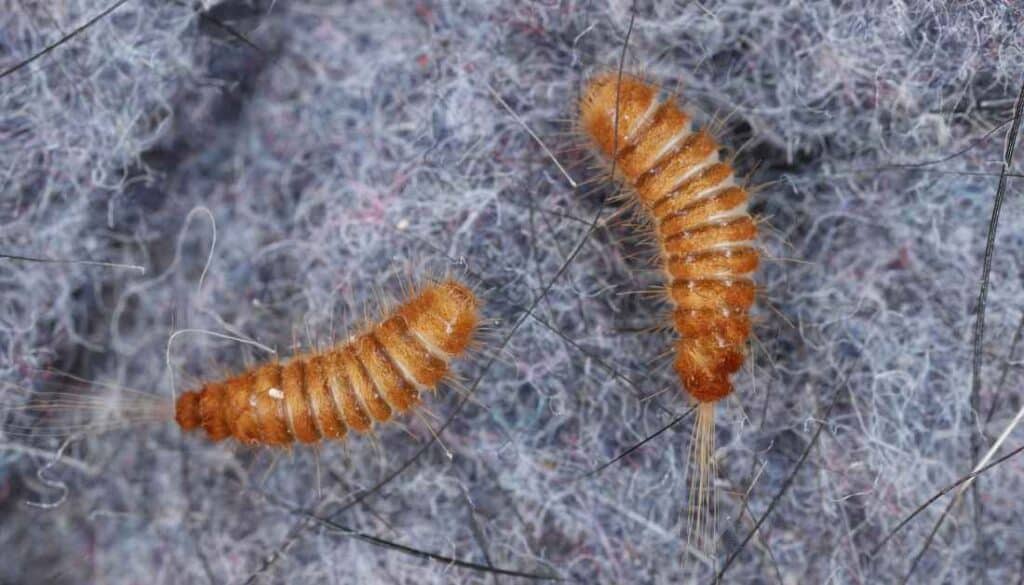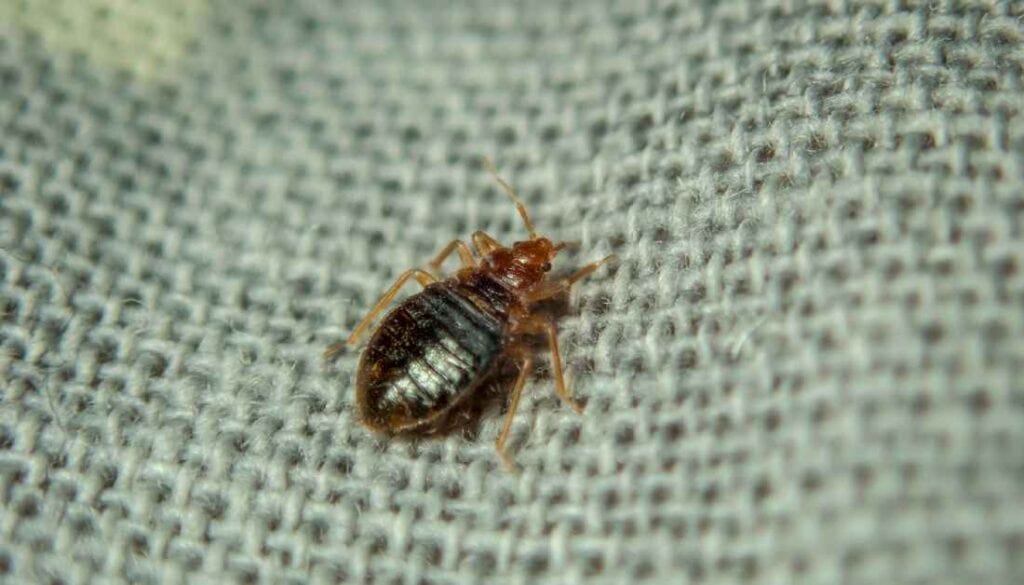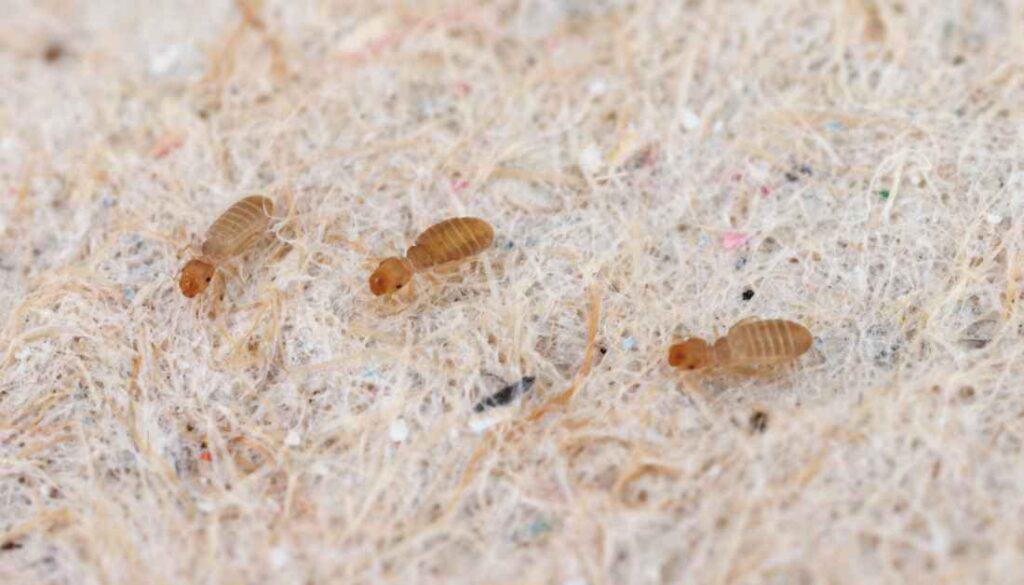Various insects, such as clothes moths, silverfish, and carpet beetles, find your closet’s dark, cozy, and undisturbed environment appealing.
Your closet provides them with places to hide and an opportunity to breed.
No wonder that many of these bugs bring risks to clothes.
The worst part? Some of these bugs can even bite and carry health risks.
In this guide, I’ll reveal the top 11 common closet pests.
You’ll find how to identify them, the telltale signs of their presence, and closet maintenance tips to keep them away.
Key Takeaways
- Identifying the pest is critical to closet bug control.
- Regular inspection and maintenance are vital for preventing bugs in the closet.
- Their presence in the closet indicates a bigger pest problem in the house.
- Professional assistance is essential for severe pest problems.
Signs of Bugs in Closet

Closet pests leave behind signs of presence that are easy to ignore. And that’s a big mistake!
Ignoring their signs gives these bugs the time to cause damage and breed. That leads to the worsening of infestation.
Here are the signs of bugs in the closet that you must look out for –
- Sightings of adult bugs in stored clothes
- Fecal droppings. These are black or gray.
- Chewed holes in clothes.
- Shed skin or cast shells. Bugs molt or shed their skin.
- Webbings on fabric
- A nasty odor
Identifying Closet Pests
In my experience, dealing with pests in the closet can be confusing. Identifying these bugs is essential to choosing the correct control methods.
I dug deep into the web and searched their pics to confidently zero in on the type of pest in my closet.
Case-Bearing Clothes Moth Larvae

Adult clothes moths invade homes and sneak into closets, wardrobes, and dresser drawers to lay their eggs.
These moths are beige or whitish, with fringed wings that give them a fuzzy appearance.
However, these adult moths are harmless. It’s their larvae that cause the damage.
Adult clothes moths lay eggs on clothes primarily made from natural fibers such as silk, wool, and fur because their larvae feed on them.
The larvae are creamy-white with brown heads. They grow up to 10 mm in size before maturing into adult clothes moths.
The larvae construct a portable case or sheath made of silk.
They cover the case with fibers from the materials they feed on, such as wool, hair, feathers, or fur.
The case is unique to these larvae and is a protective layer as the larva feeds and grows.
It drags the case along as it moves. When it is time to pupate, it seals itself inside.
The case’s appearance can help identify these pests’ presence.
If you find small, tubular cases attached to garments, upholstery, or other materials, it could be a sign of an infestation of case-bearing clothes moth larvae.
Carpet Beetle Larvae

Adult carpet beetles also show similar patterns of infestation to adult clothes moths.
They invade closets to lay their eggs so that their larvae have direct access to the food source: clothes.
The carpet beetle larvae appear like tiny black bugs in the closet. However, the larvae are dark brown and some can be tan.
The larvae have hairy bristles on their bodies. Their tapered bodies grow up to 4-5 mm in size.
Like clothes moth larvae, the carpet beetle larvae is also fabric pests.
The larvae feed on clothes made from natural fibers such as wool, feathers, leather, silk, and cotton.
They leave behind chewed holes and fecal deposits and shed skin in the closet.
Bed Bugs

Bed bugs are commonly associated with bed mattresses. But that’s wrong.
Bed bugs can spread to clothing storage sections such as closets and dresser drawers when the infestation worsens.
I found bed bugs in my carpet and couch while struggling with a severe infestation.
Bed bugs seek other places to hide when their numbers increase.
That causes them to spread to areas like closets and dresser drawers that are pretty close to bed.
Bed bugs are small brown or reddish-brown bugs with flat and oval bodies. They’re 4-5 mm in size, and these bugs are infamous human-biting and blood-sucking insects.
Cockroaches

Cockroaches are persistent pests that will sneak inside the closet to hide. They venture into the closet, looking for shelter.
It typically happens when the closet is undisturbed for many days.
However, when I researched why my closet has cockroaches, I found that closets with moisture problems attract them.
Cockroaches are not only nuisances but also disease carriers.
You can confuse tiny baby roaches with bed bugs because they’ve similar colors. But baby cockroaches are fast crawlers and have visible antennae.
Booklice or Psocids

Another pest that closets with high moisture attract is the booklice or psocids.
These are soft-bodied, tiny, clear, or tan insects that feed on molds and mildew that form on fabrics, paper products, and cardboard boxes.
Booklice have oval abdomens. They grow up to 2 mm in size.
They’re nuisance pests that don’t cause much harm to your closets. They don’t bite, either.
But they can breed fast under the humidity and temperature of the closet.
Booklice spill over to your closet from bathrooms and kitchens with high moisture content.
Termites

Termites in closets are a dangerous sign not only for your clothes but also for the house’s structural integrity.
Termites attack closets from underground or from the walls and ceiling.
Termites are wood-eating insects. They also feed on fabric and paper because both contain starch.
Termites in the closet are a clear sign that you have a termite infestation in your home.
If you’re seeing termites in your closet, then don’t wait. Hire a pest controller ASAP!
Silverfish And Firebrats

Silverfish are scaly, silvery-gray insects with tapered or teardrop-shaped bodies. They grow between 0.5 and 1 inch in size.
These insects are fabric and paper eaters.
Silverfish prefer dark and damp environments to hide. And a silverfish infestation in your home can cause these bugs to take refuge in your closet.
Silverfish will feed on the fabrics, leaving behind chewed holes in them.
They also leave their fecal deposits, yellowish marks, and shed skin in your closet’s fabric piles.
Silverfish are nocturnal insects, and they’re fast crawlers. They don’t bite, and they don’t cause any diseases either.
However, their infestation and feeding habits can harm paper products and fabrics.
Their close cousins, firebrats, are also fabric eaters. And they too can invade clothes.
Firebrats look like silverfish, albeit a bit bigger and darker than silverfish.
Crickets

Crickets are not common in closets. But they can sneak inside clothing storage sections in your house.
Crickets prefer dark and undisturbed environments. So, places like closets, storage rooms, and attics become their go-to hiding places in the house.
Crickets are tiny jumping bugs with strong hind legs. They can bite if you try to handle them.
But they don’t bring risks to your fabric like the other closet bugs on the list do.
However, their chirping at night can rob you of your sleep.
Dust Mites

Dust mites are tiny microscopic white bugs that are impossible to detect with the naked eye.
These mites are common in homes during the dust mite season, from summer to late fall.
And they tend to live in places like bed mattresses, couches, carpets, rugs, and clothes.
These mites are not fabric-eating insects. Instead, they feed on dry human skin.
Dust mites in the house gravitate towards damp areas in the house. And they’ll live in the closet on your clothes if the closet has moisture issues.
Dust mites in clothes will appear as a white dusty layer. And the clothes will smell a bit “dusty” too.
Dust mites are terrible allergens. Their feces and shed skin in the closet can enter your respiratory system and trigger allergic reactions.
Dust mites don’t bite. But their feeding on the human skin can cause itchy rashes and red welts.
Ants

Many species of home-invading ants can live in the closet.
Two common species of ants in closets are carpenter ants and pavement ants.
Carpenter ants can build their nests or colonies in the wooden structure of the closets.
Meanwhile, the pavement ants can build colonies in the closet walls and floor cracks.
Food waste in the closet and dirty clothes with food and beverage stains can also draw other ants, such as sugar ants and odorous ants.
All these ants can bite if they make contact with your skin.
So, if you wear clothes with ants, be prepared to get nasty itchy bites.
Ants don’t cause any damage to your clothes.
However, carpenter ants can structurally damage your closet by drilling holes and creating colonies.
Mice

Mice typically don’t fall under the bugs category because they’re rodents.
But I still included them in the list because mice are infamous of invading closets and wardrobes and hide in them.
They can also create their nests in the closet by chewing on the fabric.
Mice invade closets by squeezing through the gaps and cracks on walls and floor. If there is a significant gap under a closet door, mice can easily slip through.
Mice can travel through ducts and vents, finding their way into closets that share walls with these structures.
Plumbing and electrical lines and openings around windows are also pathways of mice to closets.
Mouse droppings are one of the obvious signs of mice in the closet.
Other signs mice presence in the closet include gnaw marks, smear marks, footprints and tail marks, shredded fabrics, and nasty musty odor.
I’ve found nesting materials such as shredding fabric and small mice droppings. These droppings were tiny and it clearly meant that there were mice babies in the closet.
Health Risks and Protection
When it comes to common closet bugs, the primary health concerns involve allergic reactions, potential diseases, and preventing bites.
Allergies and Diseases
Closet bugs like dust mites are notorious for triggering allergic symptoms. They can cause itchy skin, runny nose, and exacerbated asthma.
Bed bugs aren’t known to transmit diseases; however, they can cause secondary infections from the scratching of bites.
I recommend regular cleaning to reduce the presence of these allergens and minimize the risk of disease transmission from any insect fecal matter or shed skin.
Bite Prevention
Regarding bite prevention, I’ve found that the best strategy is a proactive approach.
I ensure my bedroom and closet are clean to make the environment less inviting for bed bugs and other biting insects.
Sealing cracks and crevices and using protective covers for mattresses and pillows are practical barriers against these intruders.
Closet Maintenance Tips
Regular cleaning is my first line of defense When combating closet pests, such as moths and silverfish.
I removed everything from the closet because I’ve learned that pests thrive in undisturbed, dark areas.
Vacuuming every corner and crevice once every couple of months is a tactic I use to remove any eggs or larvae that pests may have laid.
Proper storage is equally crucial. I ensure that my garments, especially those made of natural fibers to which pests are attracted, are clean before I store them.
Using airtight containers or vacuum-sealed bags, I protect my clothes from being a feast for any critter that slips in. Below is my quick checklist for efficient closet upkeep:
- Vacuum regularly: At least bi-monthly, focusing on corners and behind shelves.
- Wipe down shelves: I sanitize the surfaces using a mild cleaner to remove any potential pest attractants.
For a comprehensive list of elimination and prevention strategies, check out my article on keeping bugs out of the closet.


